ANGLE BISECTOR THEOREM WORKSHEET
Subscribe to our ▶️ YouTube channel 🔴 for the latest videos, updates, and tips.
Problem 1 :
In the ΔABC shown below, find the length of AD.

Solution :
Since CD is the angle bisector of ∠C, by Angle Bisector Theorem,
AD/DB = CA/CB
Let AD = x, DB = 6, AC = 4 and BC = 8
x/6 = 4/8
x/6 = 1/2
Doing cross multiplication, we get
2x = 6(1)
2x = 6
x = 6/2
x = 3
AD = 3 cm
So, the measure of AD is 3 cm.
Problem 2 :
In the ΔABC shown below, find the length of CD.
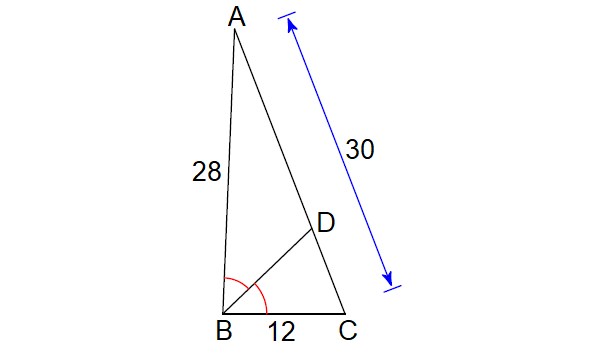
Solution :
Find the length of DA :
DA = CA - CD
= 30 - x
Since BD is the angle bisector of ∠B, by Angle Bisector Theorem,
CD/DA = BC/BA
Let CD = x, DA = 30 - x, BC = 12 and AB = 28
x/(30 - x) = 12/28
x/(30 - x) = 3/7
Doing cross multiplication, we get
7x = 3(30 - x)
7x = 90 - 3x
Add 3x to both sides.
10x = 90
Divide both sides by 10.
x = 9
CD = 9
So, the measure of CD is 9 cm.
Problem 3 :
Solve for x.
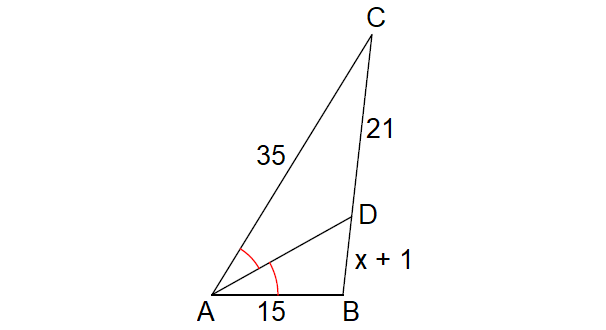
Solution :
Since AD is the angle bisector of ∠A, by Angle Bisector Theorem,
BD/DC = AB/AC
BD = x + 1, DC = 21, AB = 15 and AC = 35
(x + 1)/21 = 15/35
(x + 1)/21 = 3/7
7(x + 1) = 3(21)
7x + 7 = 63
Subtract 7 from both sides.
7x = 56
Divide both sides by 7.
x = 56/7
x = 8
Problem 4 :
Solve for x.

Solution :
Since CD is the angle bisector of ∠C, by Angle Bisector Theorem,
BD/DA = CB/CA
BD = 2, DA = 4, BC = 5 and AC = 2x - 2
2/4 = 5/(2x - 2)
Doing cross multiplication, we get
2(2x - 2) = 5(4)
4x - 4 = 20
4x = 20 + 4
4x = 24
x = 24/4
x = 6
Problem 5 :
Solve for x.
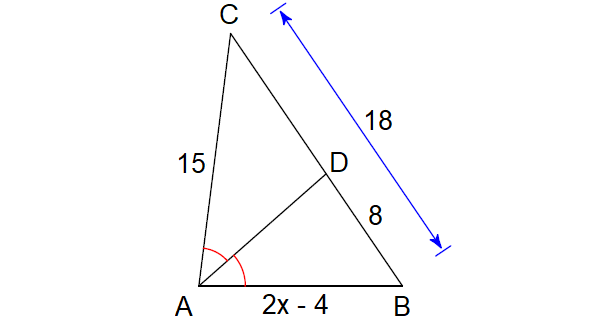
Solution :
Find the length of DC :
DC = BC - DC
= 18 - 8
= 10
Since AD is the angle bisector of ∠A, by Angle Bisector Theorem,
BD/DC = AB/AC
Substitute.
8/10 = (2x - 4)/15
4/5 = (2x - 4)/15
15(4) = 5(2x - 4)
60 = 10x - 20
Add 20 to both sides.
80 = 10x
Divide both sides by 10.
8 = x
Problem 6 :
Solve for x.
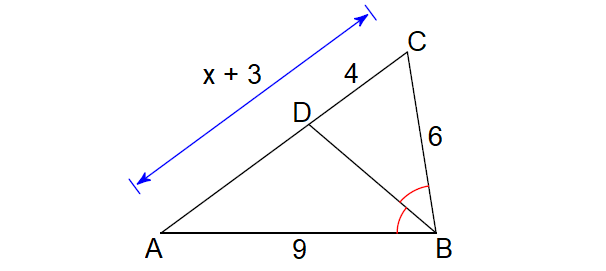
Solution :
Find the length of DA :
DA = CA - CD
= (x + 3) - 4
= x + 3 - 4
= x - 1
Since BD is the angle bisector of ∠B, by Angle Bisector Theorem,
CD/DA = BC/BA
Substitute.
4/(x - 1) = 6/9
4/(x - 1) = 2/3
3(4) = 2(x - 1)
12 = 2x - 2
Add 2 to both sides.
14 = 2x
Divide both sides by 2.
7 = x
Problem 7 :
In triangle ABC, AE is the external bisector of ∠A , meeting BC produced at E. If AB = 10 cm, AC = 6 cm and BC = 12 cm, then find CE.
Solution :
In triangle ABC, AE is the external bisector of ∠A meeting BC produced at E. Let CE = x cm. Now, by the angle bisector theorem, we have
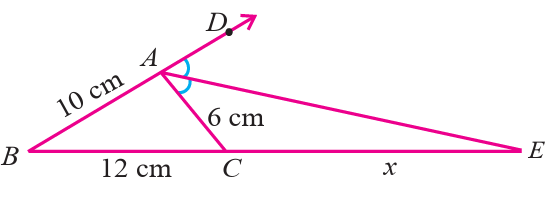
BE/CE = AB/AC
BE = BC + CE
BE = 12 + x
(12 + x)/x = 10/6
6(12 + x) = 10x
72 + 6x = 10x
72 = 10x - 6x
72 = 4x
x = 72/4
x = 18
So, the length of CE is 18 cm.
Problem 8 :
8) In triangle PQR, RS is the bisector of ∠R. If PQ = 6 cm, QR = 8 cm, RP = 4 cm then PS is equal to
(A) 2 cm (B) 4 cm (C) 3 cm (D) 6 cm
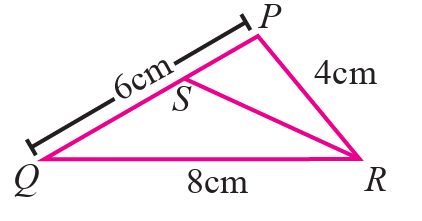
Solution :
Let QS = x, then PS = 6 - x
QR = 8 cm and PR = 4 cm
PS/QS = RP/RQ
(6 - x) / x = 4 / 8
8(6 - x) = 4x
48 - 8x = 4x
48 = 4x + 8x
48 = 12x
x = 48/12
x = 4
PS = 6 - 4 ==> 2 cm
So, the length of PS is 2 cm, option (A) is correct.
Problem 9 :
In figure, if AB/AC = BD/DC, ∠B = 40 degree and ∠C = 60 degree, then ∠BAD =
(A) 30° (B) 50° (C) 80° (D) 40°
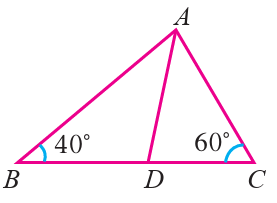
Solution :
In triangle, the sum of interior angles of triangle is equal to 180 degree
∠BAC + ∠ABC + ∠ACB = 180
∠BAC = ∠BAD + ∠DAC
and ∠BAD and ∠DAC are equall.
∠BAD + ∠DAC + 40 + 60 = 180
∠BAD + ∠DAC + 100 = 180
∠BAD + ∠DAC = 180 - 100
∠BAD + ∠DAC = 80
2∠BAD = 80
∠BAD = 80/2
∠BAD = 40
So, otpion D is correct.
Subscribe to our ▶️ YouTube channel 🔴 for the latest videos, updates, and tips.
Recent Articles
-
Finding Range of Values Inequality Problems
May 21, 24 08:51 PM
Finding Range of Values Inequality Problems -
Solving Two Step Inequality Word Problems
May 21, 24 08:51 AM
Solving Two Step Inequality Word Problems -
Exponential Function Context and Data Modeling
May 20, 24 10:45 PM
Exponential Function Context and Data Modeling